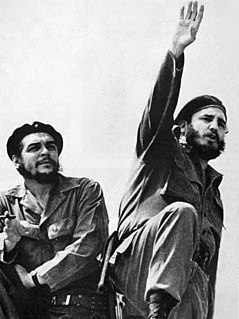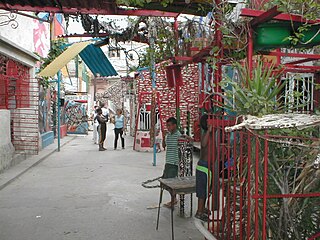This article includes a list of references, related reading or external links, but its sources remain unclear because it lacks inline citations .(August 2017) (Learn how and when to remove this template message) |
Felix René Mederos Pazos (20 November 1933 – 24 September 1996) was a prominent Cuban poster artist and graphic designer.

Cuba, officially the Republic of Cuba, is a country comprising the island of Cuba as well as Isla de la Juventud and several minor archipelagos. Cuba is located in the northern Caribbean where the Caribbean Sea, Gulf of Mexico and Atlantic Ocean meet. It is east of the Yucatán Peninsula (Mexico), south of both the U.S. state of Florida and the Bahamas, west of Haiti and north of both Jamaica and the Cayman Islands. Havana is the largest city and capital; other major cities include Santiago de Cuba and Camagüey. The area of the Republic of Cuba is 110,860 square kilometres (42,800 sq mi). The island of Cuba is the largest island in Cuba and in the Caribbean, with an area of 105,006 square kilometres (40,543 sq mi), and the second-most populous after Hispaniola, with over 11 million inhabitants.

A poster is any piece of printed paper designed to be attached to a wall or vertical surface. Typically, posters include both textual and graphic elements, although a poster may be either wholly graphical or wholly text. Posters are designed to be both eye-catching and informative. Posters may be used for many purposes. They are a frequent tool of advertisers, propagandists, protestors, and other groups trying to communicate a message. Posters also are used for reproductions of artwork, particularly famous works, and are generally low-cost compared to the original artwork. The modern poster, as we know it, however, dates back to the 1840s and 1850s when the printing industry perfected colour lithography and made mass production possible.

A graphic designer is a professional within the graphic design and graphic arts industry who assembles together images, typography, or motion graphics to create a piece of design. A graphic designer creates the graphics primarily for published, printed or electronic media, such as brochures (sometimes) and advertising. They are also sometimes responsible for typesetting, illustration, user interfaces, and web design. A core responsibility of the designer's job is to present information in a way that is both accessible and memorable.
Mederos, a self-taught artist from Sagua la Grande, began work in a Havana printshop in 1944 and was appointed Chief Designer for Cuba's principal television station in 1959. In 1964, at the beginning of the new wave of Cuban graphic design, Mederos began creating his first posters as head of the design team of the propaganda organization Intercommunications.

Havana is the capital city, largest city, province, major port, and leading commercial center of Cuba. The city has a population of 2.1 million inhabitants, and it spans a total of 781.58 km2 (301.77 sq mi) – making it the largest city by area, the most populous city, and the fourth largest metropolitan area in the Caribbean region.

Propaganda is information that is not objective and is used primarily to influence an audience and further an agenda, often by presenting facts selectively to encourage a particular synthesis or perception, or using loaded language to produce an emotional rather than a rational response to the information that is presented. Propaganda is often associated with material prepared by governments, but activist groups, companies, religious organizations and the media can also produce propaganda.
In 1969 Mederos was assigned by DOR (The Department of Revolutionary Orientation) to travel to Vietnam to paint scenes of the war. He travelled to both North and South Vietnam along the Ho Chi Minh trail with the liberation forces, experiencing first-hand the brutal conditions of war and the courageous response of the Vietnamese people. The paintings were exhibited in Hanoi, and were subsequently reproduced as a screenprinted series which has been shown all over the world. Another trip in 1972 added to the body of work. Several of these images were reproduced in the United States as part of the anti-war and Cuba solidarity efforts and in Cuba as a set of postage stamps. He also contributed to the solidarity posters produced by OSPAAAL (Organization of Solidarity with the People of Asia, Africa, and Latin America) which enjoyed worldwide distribution through the magazine Tricontinental .

Vietnam, officially the Socialist Republic of Vietnam, is the easternmost country on the Indochina Peninsula. With an estimated 94.6 million inhabitants as of 2016, it is the 15th most populous country in the world. Vietnam is bordered by China to the north, Laos and Cambodia to the west, part of Thailand to the southwest, and the Philippines, Malaysia, and Indonesia across the South China Sea to the east and southeast. Its capital city has been Hanoi since the reunification of North and South Vietnam in 1976, while its most populous city is Ho Chi Minh City.

The Vietnam War, also known as the Second Indochina War, and in Vietnam as the Resistance War Against America or simply the American War, was an undeclared war in Vietnam, Laos, and Cambodia from 1 November 1955 to the fall of Saigon on 30 April 1975. It was the second of the Indochina Wars and was officially fought between North Vietnam and South Vietnam. North Vietnam was supported by the Soviet Union, China, and other communist allies; South Vietnam was supported by the United States, South Korea, the Philippines, Australia, Thailand and other anti-communist allies. The war is considered a Cold War-era proxy war from some US perspectives. It lasted some 19 years with direct U.S. involvement ending in 1973 following the Paris Peace Accords, and included the Laotian Civil War and the Cambodian Civil War, resulting in all three countries becoming communist states in 1975.

North Vietnam, officially the Democratic Republic of Vietnam (DRV), was a country in Southeast Asia from 1945 to 1975.
In 1973 Mederos created a series of vallas (12-sheet billboards) on the history of the Cuban Revolution as well as a series of screenprints commemorating the 20th anniversary of the assault on the Moncada, the event signaling the beginning of the armed resistance to the Batista government. He continued to design vallas and posters for DOR and its successor Editora Politica (EP) on a wide range of domestic and international issues.

The Cuban Revolution was an armed revolt conducted by Fidel Castro's revolutionary 26th of July Movement and its allies against the authoritarian government of Cuban President Fulgencio Batista. The revolution began in July 1953, and continued sporadically until the rebels finally ousted Batista on 31 December 1958, replacing his government with a revolutionary socialist state. 26 July 1953 is celebrated in Cuba as the Day of the Revolution. The 26th of July Movement later reformed along communist lines, becoming the Communist Party in October 1965.

The Moncada Barracks was a military barracks in Santiago de Cuba, named after the General Guillermón Moncada, a hero of the Cuban War of Independence. On 26 July 1953, the barracks was the site of an armed attack by a small group of revolutionaries led by Fidel Castro. This armed attack is widely accepted as the beginning of the Cuban Revolution. The date on which the attack took place, 26 July, was adopted by Castro as the name for his revolutionary movement which eventually toppled the dictatorship of Fulgencio Batista on 12 January 1959.

Fulgencio Batista y Zaldívar was the elected President of Cuba from 1940 to 1944, and the U.S.-backed authoritarian ruler from 1952 to 1959, before being overthrown during the Cuban Revolution. Batista initially rose to power as part of the 1933 Revolt of the Sergeants, which overthrew the provisional government of Carlos Manuel de Céspedes y Quesada. He then appointed himself chief of the armed forces, with the rank of colonel, and effectively controlled the five-member "pentarchy" that functioned as the collective head of state. He maintained this control through a string of puppet presidents until 1940, when he was himself elected President of Cuba on a populist platform. He then instated the 1940 Constitution of Cuba and served until 1944. After finishing his term he lived in Florida, returning to Cuba to run for president in 1952. Facing certain electoral defeat, he led a military coup against President Carlos Prío Socarrás that preempted the election.
In 1991 Mederos visited the United States for the first time, where he designed and painted a mural at UCLA on U.S.–Vietnam solidarity. His last major project was a 14-panel portable mural series on Che Guevara.

The University of California, Los Angeles (UCLA) is a public research university in Los Angeles. It became the Southern Branch of the University of California in 1919, making it the third-oldest undergraduate campus of the 10-campus University of California system. It offers 337 undergraduate and graduate degree programs in a wide range of disciplines. UCLA enrolls about 31,000 undergraduate and 13,000 graduate students and had 119,000 applicants for Fall 2016, including transfer applicants, making the school the most applied-to of any American university.

Ernesto "Che" Guevara was an Argentine Marxist revolutionary, physician, author, guerrilla leader, diplomat and military theorist. A major figure of the Cuban Revolution, his stylized visage has become a ubiquitous countercultural symbol of rebellion and global insignia in popular culture.
Mederos died of cancer in Havana in 1996. His style, with its bright, firmly contoured surfaces, its ebullience of patterns in nature, and a strong, political theme, established a unique standard for graphic design in Cuba which influenced a whole generation of graphic artists all over the world.

Cancer is a group of diseases involving abnormal cell growth with the potential to invade or spread to other parts of the body. These contrast with benign tumors, which do not spread. Possible signs and symptoms include a lump, abnormal bleeding, prolonged cough, unexplained weight loss and a change in bowel movements. While these symptoms may indicate cancer, they can also have other causes. Over 100 types of cancers affect humans.

Patterns in nature are visible regularities of form found in the natural world. These patterns recur in different contexts and can sometimes be modelled mathematically. Natural patterns include symmetries, trees, spirals, meanders, waves, foams, tessellations, cracks and stripes. Early Greek philosophers studied pattern, with Plato, Pythagoras and Empedocles attempting to explain order in nature. The modern understanding of visible patterns developed gradually over time.






